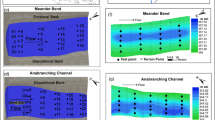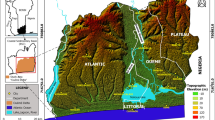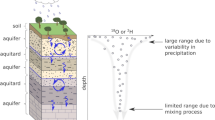Abstract
We examined groundwater and stream water interaction in the Inbuk stream, Korea, using various approaches including hydrologic, thermal, hydrochemical, and isotopic methods. For this purpose, we installed four piezometers (IYHW1–4) in the streambed at 10 m interval across the stream and at depths of 0.90 to 1.54 m. We monitored water levels and water temperatures every hour using automatic transducers at the piezometers and in the stream (IYSW1) from September 2013 to April 2014. We also analyzed chemical and isotopic compositions for the hyporheic waters, stream water, and nearby groundwater in early September and late November in 2013. The water levels and hydraulic gradients revealed that three (IYHW1, 2, and 4) of the piezometers were in upwelling conditions for most of the monitoring period, except for the earliest short period (considered to be the wet season), whereas one piezometer (IYHW3) showed a reverse behavior, indicating that the gaining was dominant in the dry period. The mean calculated influx to the stream was 3.04 × 10−4 cm/sec. Observed temperatures of stream water, hyporheic waters, and groundwater also revealed that stream water was downwelling in the early monitoring period (wet season), whereas the groundwater was generally upwelling in most of the resting period, which is consistent with the water level interpretation. Chemical composition analysis indicated that most of the waters were Ca-HCO3 type for both seasons. However, no distinctive difference between chemical compositions of water without substantial seasonal variation negated any inference on the flow conditions. The mixing ratios computed from oxygen and hydrogen isotopic compositions indicated that losing conditions were dominant in the wet season, whereas gaining conditions prevailed in the dry season. The interpretations of stream water and groundwater interactions based on these different methods are relatively consistent for this study area, indicating that such combined methods will be very useful in enhancing understanding of groundwater and stream water interaction.
Similar content being viewed by others
References
Allen, C.D., Macalady, A.K., Chenchouni, H., Bachelet, D., McDowell, N., Vennetier, M., Kitzberger, T., Rigling, A., Breshears, D.D., Hogg, E.H., Gonzales, P., Fensham, R., Zhang, Z., Castro, J., Demidova, N., Lim, J.H., Allard, G., Running S.W., Semerci, A., and Cobb, N., 2010, A global overview of drought and heat–induced tree mortality reveals emerging climate change risks for forests. Forest Ecology and Management, 259, 660–684.
Anderson, M.P., 2005, Heat as a ground water tracer. Ground Water, 43, 951–968.
Angelini, P., 1997, Correlation and spectral analysis of two hydrogeological systems in Central Italy. Hydrological Sciences Journal, 42, 425–439.
Ayenew, T., Kebede, S., and Alemyahu, T., 2008, Environmental isotopes and hydrochemical study applied to surface water and groundwater interaction in the Awash River basin. Hydrological Processes, 22, 1548–1563.
Bartolino, J.R., 2003, The Rio Grande–competing demands for a desert river. U.S. Geological Survey, Circular 1260, 96 p.
Bartsch, S., Frei, S., Ruidisch, M., Shope, C.L., Peiffer, S., Kim, B., and Fleckenstein, J.H., 2014, River–aquifer exchange fluxes under monsoonal climate conditions. Journal of Hydrology, 509, 601–614.
Brewster, C., 2004, Delineating and quantifying ground water discharge zones using streambed temperatures. Ground Water, 42, 243–257.
Brodie, R., Sundaram, B., Tottenham, R., Hostetler, S., and Ransley, T., 2007, An overview of tools for assessing groundwater–surface water connectivity. Bureau of Rural Sciences, Canberra, Australia, 131 p.
Constantz, J. and Stonestorm, D.A., 2003, Heat as a tracer of water movement near streams. U.S. Geological Survey, Circular 1260, 96 p.
Craig, H., 1961, Isotopic variations in meteoric waters. Science, 133, 1702–1703.
Hem, J.D., 1985, Study and interpretation of the chemical characteristics of natural water. Third Edition, United States Geological Survey, Water-Supply Paper 2254, 263 p.
Kalbus, E., Reinstorf, F., and Schirmer, M., 2006, Measuring methods for groundwater–surface water interactions: a review. Hydrology and Earth System Sciences, 10, 873–887.
KMA (Korean Meteorological Administration), 2014, http://kma,go.kr.
Langhoff, J.H., Rasmussn, K.R., and Christensen, S., 2006, Quantification and regionalization of groundwater–surface water interaction along an alluvial stream. Journal of Hydrology, 320, 342–358.
Larocque, M., Mangin, A., Razack, M., and Banton, O., 1998, Contribution of correlation and spectral analyses to the regional study of a large karst aquifer (Charente, France). Journal of Hydrology, 205, 217–231.
Lee, J.Y. and Lee, K.K., 2000, Use of hydrologic time series data for identification of recharge mechanism in a fractured bedrock aquifer system. Journal of Hydrology, 229, 190–201.
Lee, J.Y. and Lee, K.K., 2002, A comparative study on characteristics of waterlevel responses to rainfall in the two aquifer systems. Journal of Soil and Groundwater Environment, 7, 3–14 (in Korean with English abstract).
Marimuthu, S., Reynolds, D., and Le Gal La Salle, C., 2005, A field study of hydraulic geochemical and stable isotope relationships in a coastal wetlands system. Journal of Hydrology, 315, 93–116.
Middleton, B.A. and Kleinebecker, T., 2012, The effects of climate–change–induced drought and freshwater wetlands. Global Change Ecology and Wetlands, 1, 117–147.
Silliman, S.E. and Booth, D.F., 1993, Analysis of time-series measurements of sediment temperature for identification of gaining vs. losing portions of Juday Creek, Indiana. Journal of Hydrology, 146, 131–148.
Sophocleous, M., 2002, Interactions between groundwater and surface water: the state of the science. Hydrogeology Journal, 10, 52–67.
Song, K.Y. and Cho, D.L., 2009, Geological report of the Mandaeri sheet. Korea Institute of Geoscience and Mineral Resources, Daejeon, 72 p.
Su, G.W., Jasperse, J., Seymour, D., and Constantz, J., 2004, Estimation of hydraulic conductivity in an alluvial system using temperatures. Ground Water, 42, 890–901.
Winter, T.C., Harvey, J.W., Franke, O.L., and Alley, W.M., 1998, Ground water and surface water–a single resource. U.S. Geological Survey Circular 1139.
Yang, Z., Zhou, Y., Wenninger, J., and Uhlenbrook, S., 2014, A multi–method approach to quantify groundwater/surface water–interactions in the semi–arid Hailiutu River basin, northwest China. Hydrogeology Journal, 22, 527–541.
Author information
Authors and Affiliations
Corresponding author
Rights and permissions
About this article
Cite this article
Jeon, WH., Lee, JY., Cheong, WY. et al. A multi-method approach revealing the groundwater-stream water interaction in the Inbuk stream, Korea. Geosci J 19, 325–340 (2015). https://doi.org/10.1007/s12303-014-0043-5
Received:
Accepted:
Published:
Issue Date:
DOI: https://doi.org/10.1007/s12303-014-0043-5




